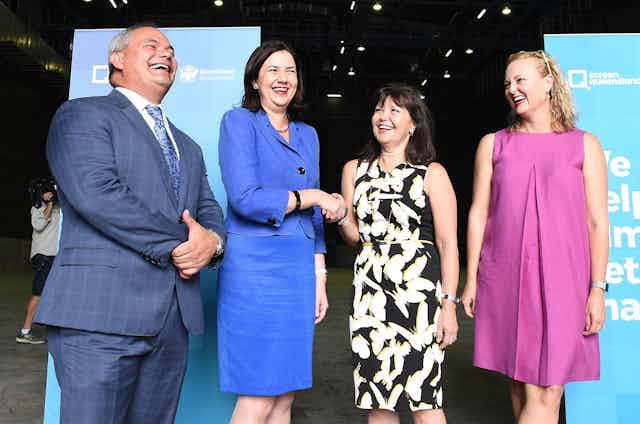Foreign minister Julie Bishop’s announcement last week that Disney’s Thor Ragnarok (2017) and Ridley Scott’s Alien prequel (2017), are coming to Australia was a welcome relief to Australia’s specialist film crews.
If, as seems likely, the two are here at the same time, so much the better. It confirms that we have the capacity and resources to manufacture more than one major film at a time.
Historically, Australia has attracted a number of foreign service productions – films developed by foreign producers but brought here for production or post production.
They are large scale and labour intensive, shot in weatherproof sound stages in Sydney, Melbourne or the Gold Coast.
For every film, specialists are employed to rig the lights, build and paint the sets, weld the steel into place, hang the green screens, create the snow, the rain, the explosions – and execute the stunts.
It’s precision work. Intricate attention to detail is required from every specialist. Cultural manufacturing, if you will.
Australia has made a big investment in training the skilled, creative thinkers who can do this work – oscillating between technical and creative challenges, in stressful, just-in-time environments.
Yet in the past five years, as-yet unpublished research (by Abi Tabone) shows that most specialists working in this space have averaged just 60% of their time in employment.
It’s their jobs that will be created when Thor and Alien come to Australia. And it’s their jobs that will evaporate when production wraps.
Reducing the white space
Attracting more large-scale productions to Australia builds the capacity of this agile, knowledge-economy workforce.
But with 40% of the year spent unemployed or out-of-industry, it’s hard for specialists to stay or make the commitment to invest in equipment, training, and critical skills transfer.
The tables below are five-year calendars of the working lives of three of Australia’s most highly-skilled and sought-after heads of film departments.



As the tables show, they’ve had to work interstate and overseas for long periods in order to sustain a living. The white space is months spent out of work. Over five years, it adds up.
The reduction of white space – where a studio remains empty, and people are not employed – should be the goal here.
It’s about building the capacity, and the consistency of work, so that the production line is closer to full capacity in the three states set up to support it.
Consistency would create a virtuous circle, with greater throughput of production enabling more investment in skills and capacity, which in turn would lead to improved and more efficient service delivery, resulting in a more competitive offering, which would attract more production – and so on.
Film production operates in a global marketplace. The trend over the past 15 to 20 years has been for Hollywood studios to write and package their films at home, and then shop them around the world to be made offshore.
The federal government continues to pursue these productions because they attract foreign investment, create opportunities for Australian cast and crew, and produce residual benefits for the local screen ecology.
We’re close. Certainly the falling dollar will help. But fundamentally, the policy design should be robust enough to withstand dollar fluctuations, so that this work can flourish.
The knowledge economy at work
This is the knowledge economy at work. The production methodologies employed are cutting-edge. They change rapidly. Film sits at a neat juncture between creative ideas and technical execution.
It’s the kind of work a future-looking Australia should be celebrating: collaborative, intricate, and highly skilled.
The next phase in foreign service production is for the sector to work closely with government, aligning metrics and key performance indicators that move beyond one or two “good news” announcements annually or a simply tally of jobs created – which as Jason Potts has noted on The Conversation, can be hard to measure and are often overstated.
Cultural manufacturing does create jobs. But it also contributes to technical breakthroughs, unusual problem-solving, and the development of new filmmaking technologies. Many of these may have applications beyond the film industry, in scientific, health and media fields.
Focusing on the work itself – not just the Hollywood stars who come to town – will increase the absorptive capacity of the foreign service production sector.
It will build a sector that can attract and retain the best talent, engineer cleaner, greener production methodologies, identify technical brilliance, and share it with the world. A sector that can help reposition Australia as a high-performing partner, serving the global imagination.
And a sector that can contribute to Prime Minister Turnbull’s vision of an Australia that “is agile, that is innovative, that is creative”.

